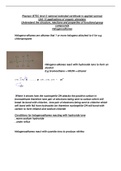Class notes
BTEC Applied Science: Unit 14 Assignment A
- Course
- Institution
A. P1 A. M1 A.M2 A. D1 Criteria's Met. Learning Aim A: (Distinction - Understand the Properties, Reactions, and Structures, of Functional Group Compounds. Distinction Grade Achieved throughout the whole Unit 14 Assignment. Includes detailed description of Organic chemistry and the different organ...
[Show more]



